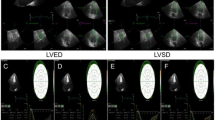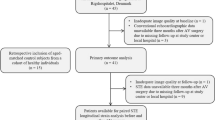Abstract
The present study evaluated change in left ventricle (LV) biomechanics, layer-by-layer, following acute pressure unloading in patients with severe aortic stenosis (AS). In twenty-eight consecutive patients with severe AS who underwent transcatheter aortic valve replacement (TAVR), LV peak global longitudinal and circumferential strains of the endo-, midmyo- and epicardium were evaluated using multilayer speckle tracking echocardiography before, 1 week after, and 1 month after TAVR. Longitudinal and circumferential strains were significantly highest in the endocardium and lowest in the epicardium at baseline. At 1 month following TAVR, longitudinal strain significantly improved in all layers compared with the baseline [endocardium (%) −16.7 ± 3.8 vs. −18.6 ± 3.3, P = 0.01; mid-myocardium −14.4 ± 3.2 vs. −16.2 ± 3.5, P < 0.01; epicardium −12.4 ± 2.8 vs. −13.6 ± 2.6, P = 0.01], whereas LV ejection fraction and circumferential strain remained unchanged. Importantly, only those with LV hypertrophy demonstrated improved longitudinal strain [endocardium (%) −15.7 ± 3.0 vs. −18.7 ± 2.9, P < 0.01; mid-myocardium −13.6 ± 2.7 vs. −16.0 ± 2.5, P < 0.01; epicardium −11.8 ± 2.4 vs. −13.7 ± 2.3, P < 0.01]. The improvement in longitudinal strain was more prominent in the endocardium, which was evident even at an early time point (1 week) after TAVR. Longitudinal strain significantly improved in all three layers following acute pressure unloading, the most prominent of which was observed in the endocardium. Evaluation of multilayer strain may provide new insights into the LV mechanics in the future.





Similar content being viewed by others
Abbreviations
- AS:
-
Aortic stenosis
- AV:
-
Aortic valve
- AVA:
-
Aortic valve area
- AR:
-
Aortic regurgitation
- CW:
-
Continuous wave
- EF:
-
Ejection fraction
- GCS:
-
Global circumferential strain
- GLS:
-
Global longitudinal strain
- ICC:
-
Intraclass correlation coefficient
- IVSd:
-
Inter-ventricular septal thickness
- LV:
-
Left ventricle
- LVEDD:
-
LV end-diastolic diameter
- LVESD:
-
LV end-systolic diameter
- LVH:
-
LV hypertrophy
- LVPWd:
-
LV posterior wall thickness at diastole
- LVMI:
-
LV mass index
- PG:
-
Pressure gradient
- SD:
-
Standard deviation
- TAVR:
-
Transcatheter aortic valve replacement
References
Hyodo E, Arai K, Koczo A, Shimada YJ, Fujimoto K, Di Tullio MR, Homma S, Gillam LD, Hahn RT (2012) Alteration in subendocardial and subepicardial myocardial strain in patients with aortic valve stenosis: an early marker of left ventricular dysfunction? J Am Soc Echocardiogr 25(2):153–159
Staron A, Bansal M, Kalakoti P, Nakabo A, Gasior Z, Pysz P, Wita K, Jasinski M, Sengupta PP (2013) Speckle tracking echocardiography derived 2-dimensional myocardial strain predicts left ventricular function and mass regression in aortic stenosis patients undergoing aortic valve replacement. Int J Cardiovasc Imaging 29(4):797–808
Iwahashi N, Nakatani S, Kanzaki H, Hasegawa T, Abe H, Kitakaze M (2006) Acute improvement in myocardial function assessed by myocardial strain and strain rate after aortic valve replacement for aortic stenosis. J Am Soc Echocardiogr 19(10):1238–1244
Delgado V, Tops LF, van Bommel RJ, van der Kley F, Marsan NA, Klautz RJ, Versteegh MI, Holman ER, Schalij MJ, Bax JJ (2009) Strain analysis in patients with severe aortic stenosis and preserved left ventricular ejection fraction undergoing surgical valve replacement. Eur Heart J 30(24):3037–3047
Giannini C, Petronio AS, Talini E, De Carlo M, Guarracino F, Grazia M, Donne D, Nardi C, Conte L, Barletta V, Marzilli M, Di Bello V (2011) Early and late improvement of global and regional left ventricular function after transcatheter aortic valve implantation in patients with severe aortic stenosis: an echocardiographic study. Am J Cardiovasc Dis 1(3):264–273
Leitman M, Lysiansky M, Lysyansky P, Friedman Z, Tyomkin V, Fuchs T, Adam D, Krakover R, Vered Z (2010) Circumferential and longitudinal strain in 3 myocardial layers in normal subjects and in patients with regional left ventricular dysfunction. J Am Soc Echocardiogr 23(1):64–70
Ohara Y, Fukuoka Y, Tabuchi I, Sahara S, Hosogi S, Nishimoto M, Yamamoto K (2012) The impairment of endocardial radial strain is related to aortic stenosis severity in patients with aortic stenosis and preserved LV ejection fraction using two-dimensional speckle tracking echocardiography. Echocardiography 29(10):1172–1180
Manaka M, Tanaka N, Takei Y, Kurohane S, Takazawa K, Yamashina A (2005) Assessment of regional myocardial systolic function in hypertensive left ventricular hypertrophy using harmonic myocardial strain imaging. J Cardiol 45(2):53–60
Lang RM, Bierig M, Devereux RB, Flachskampf FA, Foster E, Pellikka PA, Picard MH, Roman MJ, Seward J, Shanewise JS, Solomon SD, Spencer KT, Sutton MS, Stewart WJ, Chamber Quantification Writing G, American Society of Echocardiography’s G, Standards C, European Association of E (2005) Recommendations for chamber quantification: a report from the American Society of Echocardiography’s Guidelines and Standards Committee and the Chamber Quantification Writing Group, developed in conjunction with the European Association of Echocardiography, a branch of the European Society of Cardiology. J Am Soc Echocardiogr 18(12):1440–1463
Quinones MA, Otto CM, Stoddard M, Waggoner A, Zoghbi WA, Doppler Quantification Task Force of the N, Standards Committee of the American Society of E (2002) Recommendations for quantification of Doppler echocardiography: a report from the Doppler Quantification Task Force of the Nomenclature and Standards Committee of the American Society of Echocardiography. J Am Soc Echocardiogr 15(2):167–184
Becker M, Bilke E, Kuhl H, Katoh M, Kramann R, Franke A, Bucker A, Hanrath P, Hoffmann R (2006) Analysis of myocardial deformation based on pixel tracking in two dimensional echocardiographic images enables quantitative assessment of regional left ventricular function. Heart 92(8):1102–1108
Altiok E, Neizel M, Tiemann S, Krass V, Kuhr K, Becker M, Zwicker C, Koos R, Lehmacher W, Kelm M, Marx N, Hoffmann R (2012) Quantitative analysis of endocardial and epicardial left ventricular myocardial deformation-comparison of strain-encoded cardiac magnetic resonance imaging with two-dimensional speckle-tracking echocardiography. J Am Soc Echocardiogr 25(11):1179–1188
Nashef SA, Roques F, Sharples LD, Nilsson J, Smith C, Goldstone AR, Lockowandt U (2012) EuroSCORE II. Eur J Cardiothorac Surg 41(4):734–744
Sengupta PP, Korinek J, Belohlavek M, Narula J, Vannan MA, Jahangir A, Khandheria BK (2006) Left ventricular structure and function: basic science for cardiac imaging. J Am Coll Cardiol 48(10):1988–2001
Monte IP, Mangiafico S, Buccheri S, Arcidiacono AA, Lavanco V, Privitera F, Leggio S, Deste W, Tamburino C (2014) Early changes of left ventricular geometry and deformational analysis in obese subjects without cardiovascular risk factors: a three-dimensional and speckle tracking echocardiographic study. Int J Cardiovasc Imaging 30(6):1037–1047
Chen J, Liu W, Zhang H, Lacy L, Yang X, Song SK, Wickline SA, Yu X (2005) Regional ventricular wall thickening reflects changes in cardiac fiber and sheet structure during contraction: quantification with diffusion tensor MRI. Am J Physiol Heart Circ Physiol 289(5):H1898–H1907
Seo Y, Ishizu T, Atsumi A, Kawamura R, Aonuma K (2014) Three-dimensional speckle tracking echocardiography. Circ J 78(6):1290–1301
Schattke S, Baldenhofer G, Prauka I, Zhang K, Laule M, Stangl V, Sanad W, Spethmann S, Borges AC, Baumann G, Stangl K, Knebel F (2012) Acute regional improvement of myocardial function after interventional transfemoral aortic valve replacement in aortic stenosis: a speckle tracking echocardiography study. Cardiovasc Ultrasound 10:15
Lee SP, Kim YJ, Kim JH, Park K, Kim KH, Kim HK, Cho GY, Sohn DW, Oh BH, Park YB (2011) Deterioration of myocardial function in paradoxical low-flow severe aortic stenosis: two-dimensional strain analysis. J Am Soc Echocardiogr 24(9):976–983
Moen CA, Salminen PR, Dahle GO, Hjertaas JJ, Grong K, Matre K (2013) Multi-layer radial systolic strain vs. one-layer strain for confirming reperfusion from a significant non-occlusive coronary stenosis. Eur Heart J Cardiovasc Imaging 14(1):24–37
Sarvari SI, Haugaa KH, Zahid W, Bendz B, Aakhus S, Aaberge L, Edvardsen T (2013) Layer-specific quantification of myocardial deformation by strain echocardiography may reveal significant CAD in patients with non-ST-segment elevation acute coronary syndrome. JACC Cardiovasc Imaging 6(5):535–544
Adamu U, Schmitz F, Becker M, Kelm M, Hoffmann R (2009) Advanced speckle tracking echocardiography allowing a three-myocardial layer-specific analysis of deformation parameters. Eur J Echocardiogr 10(2):303–308
Sakurai D, Asanuma T, Masuda K, Hioki A, Nakatani S (2014) Myocardial layer-specific analysis of ischemic memory using speckle tracking echocardiography. Int J Cardiovasc Imaging 30(4):739–748
Rajappan K, Rimoldi OE, Dutka DP, Ariff B, Pennell DJ, Sheridan DJ, Camici PG (2002) Mechanisms of coronary microcirculatory dysfunction in patients with aortic stenosis and angiographically normal coronary arteries. Circulation 105(4):470–476
Carabello BA (1995) The relationship of left ventricular geometry and hypertrophy to left ventricular function in valvular heart disease. J Heart Valve Dis 4(Suppl 2):S132–S138 (discussion S138–S139)
Schwartzkopff B, Frenzel H, Dieckerhoff J, Betz P, Flasshove M, Schulte HD, Mundhenke M, Motz W, Strauer BE (1992) Morphometric investigation of human myocardium in arterial hypertension and valvular aortic stenosis. Eur Heart J 13(Suppl D):17–23
Cramariuc D, Gerdts E, Davidsen ES, Segadal L, Matre K (2010) Myocardial deformation in aortic valve stenosis: relation to left ventricular geometry. Heart 96(2):106–112
Badran HM, Faheem N, Ibrahim WA, Elnoamany MF, Elsedi M, Yacoub M (2013) Systolic function reserve using two-dimensional strain imaging in hypertrophic cardiomyopathy: comparison with essential hypertension. J Am Soc Echocardiogr 26(12):1397–1406
Carasso S, Cohen O, Mutlak D, Adler Z, Lessick J, Aronson D, Reisner SA, Rakowski H, Bolotin G, Agmon Y (2011) Relation of myocardial mechanics in severe aortic stenosis to left ventricular ejection fraction and response to aortic valve replacement. Am J Cardiol 107(7):1052–1057
Carasso S, Mutlak D, Lessick J, Reisner SA, Rakowski H, Agmon Y (2014) Symptoms in severe aortic stenosis are associated with decreased compensatory circumferential myocardial mechanics. J Am Soc Echocardiogr 28(2):218–225
Nakatani S (2011) Left ventricular rotation and twist: why should we learn? J Cardiovasc Ultrasound 19(1):1–6
Acknowledgments
We thank Sun-Jin Kim, RN, RDCS and Tae-Kyeong Lee, RN for their help in taking care of the database and Mi-Kyeong Hong, RDCS for her help in analyzing the strain data.
Grants
This study was supported by an unrestricted grant from Yuhan pharmaceuticals (Grant No. 0620140450).
Author information
Authors and Affiliations
Corresponding author
Ethics declarations
Conflict of interest
No conflicts of interest, financial or otherwise, are declared by the authors.
Electronic supplementary material
Below is the link to the electronic supplementary material.
Rights and permissions
About this article
Cite this article
Kim, HJ., Lee, SP., Park, C.S. et al. Different responses of the myocardial contractility by layer following acute pressure unloading in severe aortic stenosis patients. Int J Cardiovasc Imaging 32, 247–259 (2016). https://doi.org/10.1007/s10554-015-0759-y
Received:
Accepted:
Published:
Issue Date:
DOI: https://doi.org/10.1007/s10554-015-0759-y




